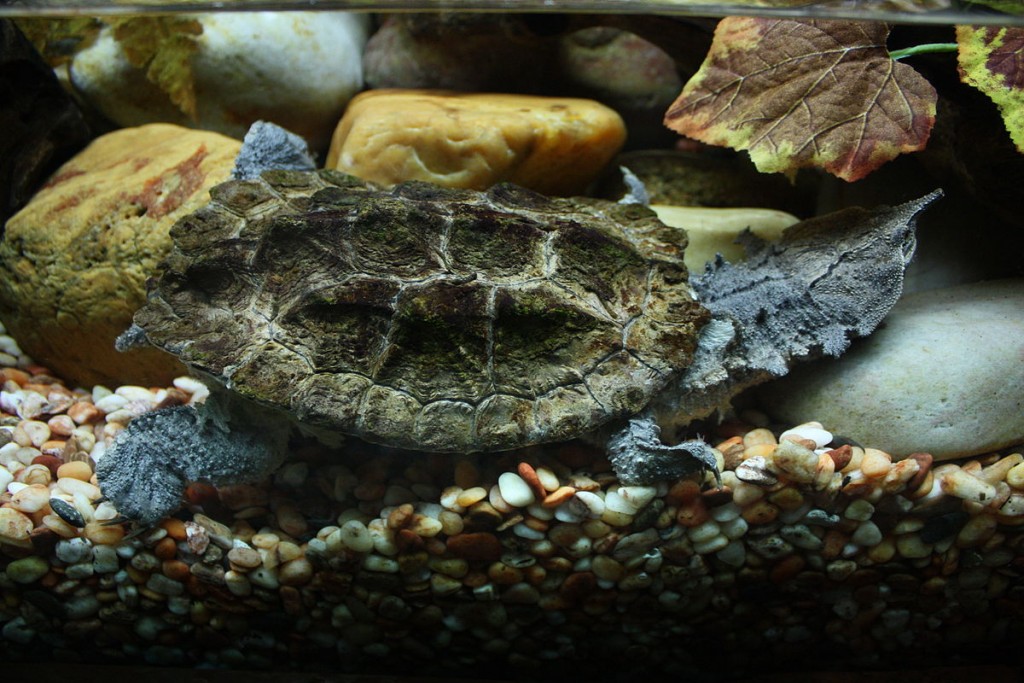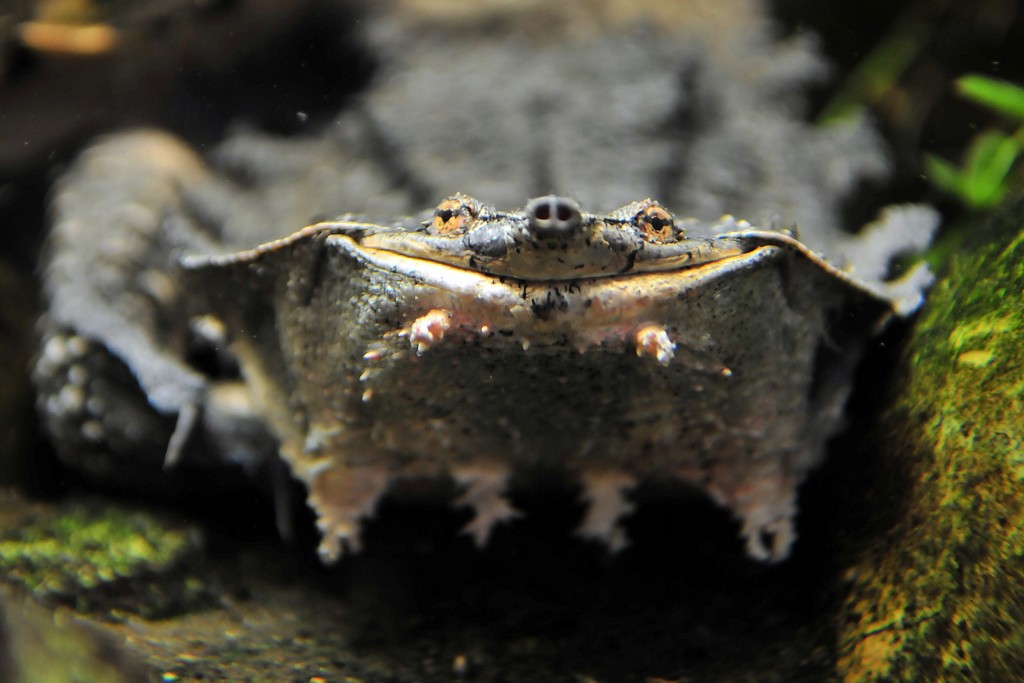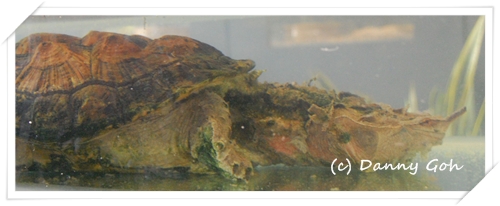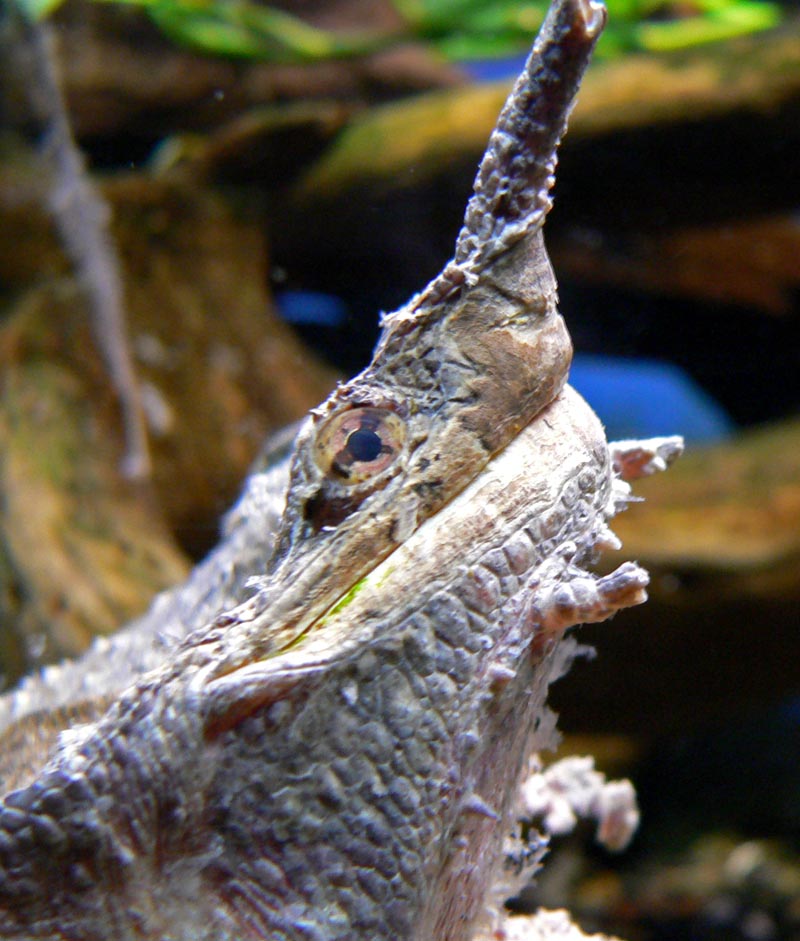The mata mata turtle, mata-mata, or matamata (Chelus fimbriata) is a freshwater turtle found in South America, primarily in the Amazon River and its tributaries in Peru, Venezuela, Guiana, and Brazil. It is the only existing species in the genus Chelus, making it truly unique.
Interesting Mata Mata Turtle Facts
The mata mata turtle is a sedentary turtle with a large, triangular, flattened head. Other distinguishing features of the head are that it is covered in tubercles, flaps of skin, and even has a “horn” on its snout! The mata mata also has 3 barbels on the chin and 4 more filamentous barbels at the upper jaw.
- The mata mata turtle’s shell, or carapace, is usually black or brown and can measure up to 18 inches (45 cm) at maturity.
- The full adult weight is 33 pounds (15 kg).
- The mata mata turtle looks like a piece of bark, giving it an effective camouflaging it from predators.
- The neck is longer than the vertebra under its carapace (shell) and is fringed with small skin flaps along both sides.
- A mata mata’s jaw is not hooked or notched
- Each fore foot has five webbed claws. Males have concave plastrons (breastplate) and longer, thicker tails than females.

Mata Mata Turtles in the Wild
- The mata mata can be found in slow moving, blackwater streams, stagnant pools, and marshes.
- The mata mata is strictly an aquatic species but it prefers standing in shallow water where its snout can reach the surface to breathe.
Mata Mata Turtle Behavior
As I mentioned earlier, the mata mata’s shell resembles a piece of bark, and its head looks like leaves. The turtle stays quite motionless in the water. When a fish swims closeby, the mata mata turtle sticks its head out and opens its large mouth as wide as possible. This action creates a low-pressure vacuum that sucks the prey into its mouth! The mata mata then snaps its mouth shut, expels the water, and swallows the fish whole. It is actually unable to chew due to the way its mouth is constructed.
Reproduction
- Males display for females by extending their limbs, lunging their heads toward the females with mouths agape, and moving the lateral flaps on their heads.
- Nesting occurs from October through December in the Upper Amazon.
- The 12 to 28 brittle, spherical, 35 mm-diameter eggs are deposited in a clutch.
Diet
The mata mata is a carnivorous turtle, feeding exclusively upon aquatic invertebrates and fish.

In captivity
- Mata mata turtles are obtainable in the exotic pet trade and are quite expensive. Because their appearance is so unique, they make an interesting display. Even though they can grow quite large (up to 18″), they do not need a lot of space, since they are not very active and do not hunt.
- They do not handle well and handling can lead to stress.
- As with all aquatic turtles, water quality is one of the keys to keeping this species successfully in captivity. Warm, acidic water is the best type used with a high tannin content that should be maintained all year round. Moderate to heavy filtration is recommended.
For more information about taking care of a Mata Mata Turtle Pet, visit: Animal-World
********
Mata Mata Turtle Facts, Unique, One of a Kind Turtle Share on X
***************

Sources:
Featured Image: Mata Mata Turtle, “Chelus fimbriatus close” by Stan Shebs – Own work. Licensed under GFDL via Wikimedia Commons
- Mindful Travel With Your Dog This Holiday Season - December 23, 2019
- A-Z of Australia’s Endangered Wildlife - December 20, 2019
- Teaching Your Kids How to Walk the Dog Safely - December 2, 2019


Thank you!!!!!!!!!
You’re quite welcome, Olivia.
What a cool turtle, I like it! It reminds me of when I was kid and had a turtle pen. I spent a lot of fun filled days taking care of my snapper babies and searching for more along our lowland creek. Thanks Jeannie.
I’ll bet you were such a cute little boy, Jon. 🙂 I can almost picture now. Thanks for your comment. 🙂
I would love to see one of these up close. This is a very unique animal. Looks so cool!
I’d love to see one up close too, Nate. What a strange looking turtle, isn’t it? Thanks for stopping by my blog to day. I always appreciate it when you do. 🙂
I know a turtle obsessed seven year old who would love to read this- fascinating. I saw one of these guys at the Bronx Zoo yesterday!
You saw one yesterday! Oh, how fun! I haven’t seen one in ‘person’ yet. I’d love to though. I hope you share this with that special 7-year-old! Thanks for stopping by, Sojourner.